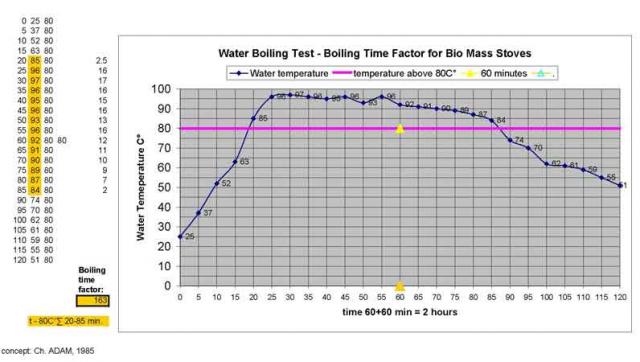Dean Still on Stove Performance Tests and Chris Adam's Proposed Boiling Time Factor Test
Chris Adam, Discussion on the Biomass Cooking Stoves List June 2006
Dear Dean, dear Kevin, dear Tom
I just see your discussion on "determining effectiveness" and I send you my contribution I gave to the stove list in March 2006,
I want to make a proposal for a new Stove-Testing-Concept.
I also enclose you a sample an excel sheet: BCSt_BPFactor_Chart02.xls the boiling time factor will be in this case of this institutional stove "163"
which is the surface of the curve above the red line on the graph.
In a word: You use the size of surface (=mm x mm or mm2, it gives a number) of the temperature curve as an indicator for the quality of the stove!
This number I call " BTF= boiling time factor "
I can draft a curve of the water temperature over time. And i take into account the surface of the temperature curve above 80°C. This is normally the temperature which is helpful for the cooking process.
The temperature is taken and noted every 5 Minutes. The test goes over 2 hours. All the fuel is used during the first hour. That means after the second hour all the fuel is burned.
No need to search for left-over pieces charcoal.
What's the idea behind this stove testing method?
I worked with fuel saving stoves in 1982 and 1985. I always disliked the ARLINGTON STOVE TESTING Procedures from 1982 (Percentage heat utilized) because it means-
stopping the fire, weighting the charcoal, restarting the fire (continuing) the fire from new.
Especially for larger community stoves with bigger fire- I really found this method improper.
* The BTF procedure takes into account if the stove is a low-mass or a high mass stove.
* It takes into account if the stove heats up quickly
* It takes into account if the stoves keeps the heat after the fuel is burned. (Also the chimney quality/damper effectiveness).
This is because no fuel is added after one hour. A quick drop of temperature (smaller surface on the monitoring paper, steeper dropping angle) indicates a not-so-good stove.
* If the temperature is kept for a while (larger surface and slower angle on the monitoring paper) this gives an indication for a good stove.
So once more:
1) The stove testing times goes over 2 phases: One hour of heating, one hour when no fuel added.
2) You start to make a quick fire and reach the boiling point quickly. Afterwards the fuel is evenly distributed for the remaining hour.
3) The amount of water boiled should always be the same (2 litres for regular stoves (or 16 litre for community stoves))
4) The fuel is taken by volume (e.g. an empty can of about 1(?) liter,~0,5kg(?), (or 8 (?) liter, ~4kg(?) for community stoves) filled with fuel) but the weight is exactly noted.
5) The water evaporated is measured in case a "Percentage heat utilized" figure wants to be calculated.
However the objective of the BTF is not to evaporate water- but to heat up water quickly and to keep it up hot over an extended period in relation to little fuel used.
A fixed amount of water and fixed amount of fuel is used for all the different test.
Calculations:
There is no need to use integral calculations for finding the "surface above 80°C", simple use this formula: add up all "water temperature minus-80°C" every 5 minutes.
For example:
water temperature: 05min= 85°C, 10min=93°C, 15min=96°C, 20min=96°C, 25min=97°C, 35min=97°C, 40min=97°C, 45min=97°C, 50min=97°C, 55min=97°C, 60min=97°C, // 65min=97°C, 70min=93°C, 75min=90°C, 80min=85, 85min =81°C,
BTF, Boiling time factor: 5+13+16+17+17+17+17+17+17+17+17+13+10+5+1 = 199
This number can give a universal classification for the quality of a stove in relation to other stoves.
(For instance also categories could be made, like we have them shown on labels on all new fridges which are sold in Europe.
A= for best energy efficiency, B= for acceptable energy efficiency, C= for low energy efficiency).
regards
Chris ADAM
Dean Still schrieb:
Dear Tom and Kevin,
Field and lab testing is an interesting and complicated subject with a long
history of discussion. To me the discussion becomes easier to define when it
is centered on what testing best meets the goal of helping the folks using
cooking stoves.
An experiment costs less if variables can be eliminated or diminished. In
the lab this means using the same wood, out of the wind, using the same pot,
etc. In this way the stove performance becomes what is being tested. Lab
experiments using the standardized Water Boiling Test can identify what improves performance on many measures like time to boil, wood use,
emissions, energy used, etc. The miles per gallon rating on new cars is an
example of the usefulness of lab comparisons. Lab work is the fastest way to
learn how heat transfer and combustion efficiency can be improved.
In my opinion, it is necessary to have cooks invent their own stoves. The
variables often most important to cooks have nothing to do with the above
measures. How a stove cooks their recipes can be more important. Cooks want
a stove to be effective, perhaps more than wanting it to be "efficient".
(Thanks, Mark Bryden.)Teaching cooks how stoves work and evolving solutions
with their input has been recommended again and again as the quickest, most
dependable way to develop appropriate technology.
The Controlled Cooking Test is often used in the field. Cooks prepare their
recipes using their wood, pots, etc. An older stove can be compared in this
way to a newer model. Subjective opinions are welcome and give needed
feedback to a stove development team (cooks, engineers, managers,
implementers, etc.)
Stoves in use are evaluated using the Kitchen Performance Test which is an
'anthropological' survey of the stove in the environment.
All three tests are needed to determine effectiveness. That's why since 1987
these tests have been the international standard.
Best,
Dean

